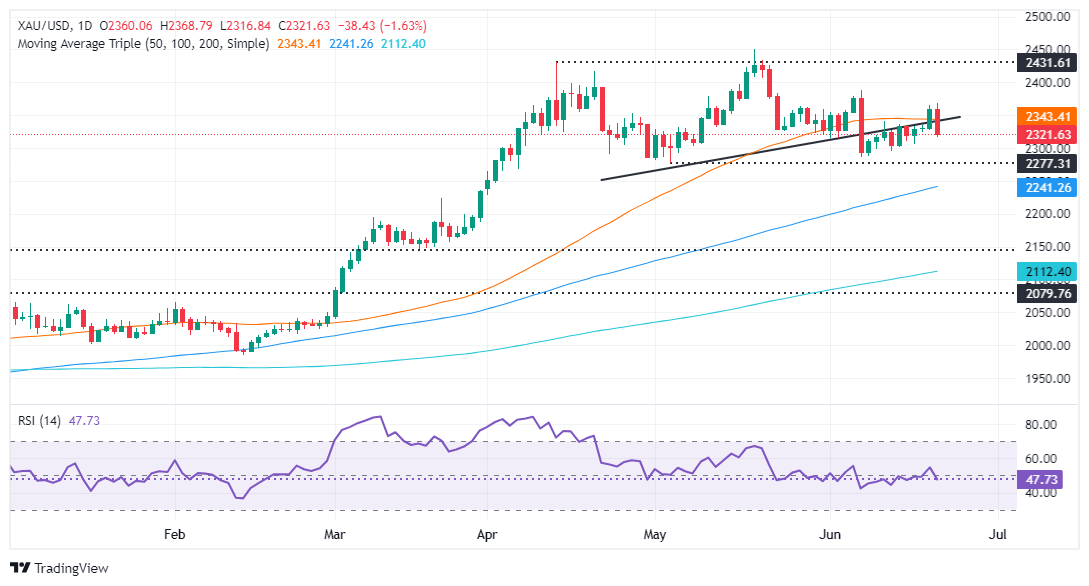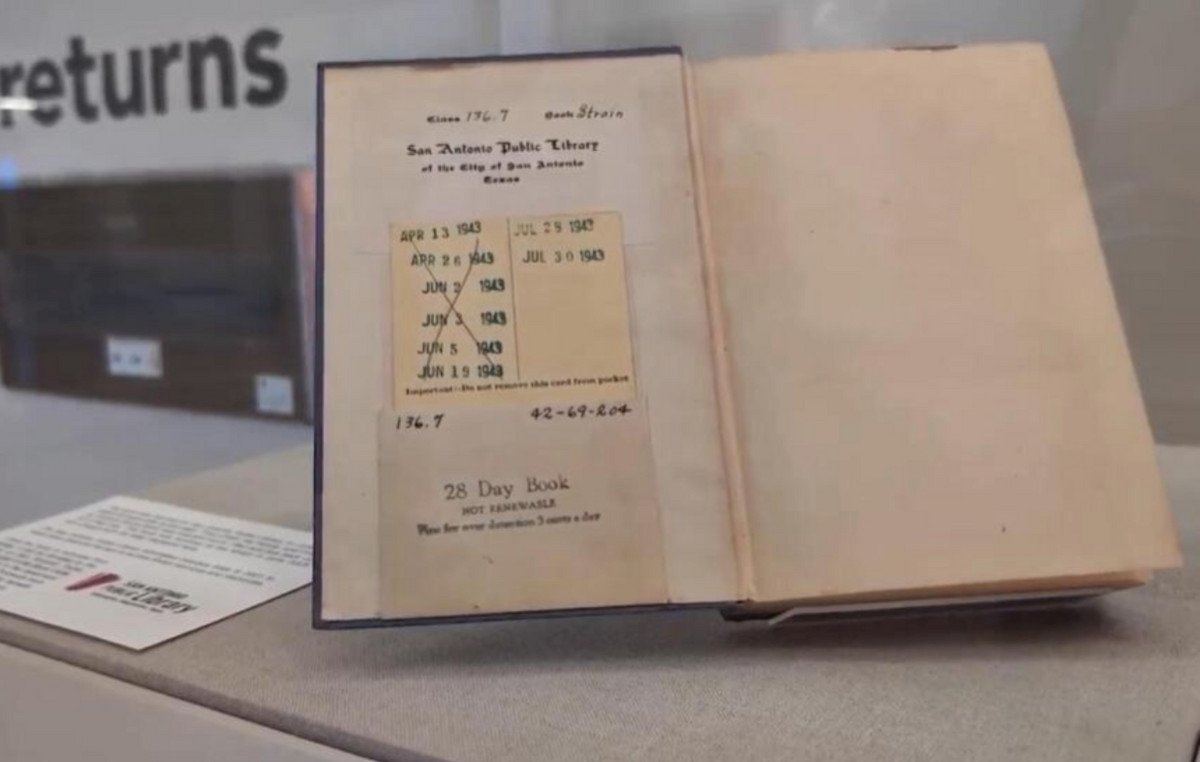- Gold reverses gains after reaching a daily high of $2,368, falling more than 1.70%.
- Strong US S&P Global PMI data boosts the US Dollar, with the DXY rising 0.14% to 105.80.
- Mixed US economic data keeps speculation alive about a Fed rate cut.
Gold prices reversed course on Friday, falling more than 1.70%. Economic data from the United States (US) fueled investor reaction by pricing in fewer interest rate cuts by the Federal Reserve (Fed) due to the strong state of the economy. XAU/USD is trading at $2,317, below its opening price after reaching a daily high of $2,368.
The US economy continued to give mixed signals about its strength. S&P Global revealed June Purchasing Managers’ Index (PMI) readings, which beat estimates and surpassed May data. However, the US housing sector continued to deteriorate after May existing home sales disappointed expectations and fell compared to April data.
Following the release of the PMI, investors exited gold and bought the Dollar, which, according to the US Dollar Index (DXY), rose 0.14% to 105.80.
US data released during the week highlights the uncertainty, as some economic indicators reiterate that the economy remains strong. On the positive side, industrial production, preliminary S&P PMIs and retail sales all advanced, although the latter were lower than the previous month.
Instead, housing continued to deteriorate, while the labor market, as measured by Americans’ jobless claims, came in worse than expected. The data kept alive investors’ chances of a Fed rate cut in September.
Given the context, gold prices continued to fall, along with technical indicators, pointing to a correction after a three-month rally that began in March and lifted XAU/USD to its all-time high of $2,450.
The CME FedWatch tool shows odds of a 25 basis point Fed rate cut in September at 59.5%, up from 57.5% on Thursday. Meanwhile, the December 2024 federal funds rate futures contract implies the Fed will cut 36 basis points by the end of the year.
Market Drivers: Gold Price Falls Due to Strong US Dollar
- US Treasury yields remain firm, with the 10-year bond yield flat at 4.261%.
- S&P Global’s preliminary manufacturing and services PMIs for June beat estimates. The Manufacturing PMI rose to 51.7, from 51.3 and beating the estimate of 51. The Services PMI rose from 54.8 to 55.1, beating the forecast of 53.7.
- US existing home sales in May were lower than expected, falling to 4.11 million from 4.14 million in April, representing a contraction of -0.7%.
- Fed officials advised patience regarding interest rate cuts, emphasizing that their decisions would continue to depend on data. Despite last week’s positive CPI report, policymakers reiterated the need to see more data similar to May’s before considering any changes.
- Even though the US CPI report showed that the disinflation process continues, Fed Chair Jerome Powell commented that they remain “less confident” about progress in inflation.
Technical Analysis: Gold Price Falls Below Neck of Head-Shoulder Pattern, Targets $2,300
Gold’s downtrend resumed on Friday after buyers tested the head-shoulder pattern, dragging the XAU/USD price above the pattern’s neckline. Despite achieving a daily close above the latter, sellers defended the neck and pushed the spot price to a new three-day low of $2,316.
That being said, the path of least resistance is down. The next support would be $2,300. Once cleared, XAU/USD would fall to $2,277, the May 3 low, followed by the March 21 high of $2,222. More losses lie below, with sellers targeting the head-shoulder pattern target of $2,170 to $2,160.
Conversely, if Gold reclaims $2,350, that will expose additional key resistance levels such as the June 7 cycle high of $2,387, before challenging the $2,400 figure.
Gold
Gold has played a fundamental role in human history, as it has been widely used as a store of value and medium of exchange. Today, aside from its brilliance and use for jewelry, the precious metal is considered a safe haven asset, meaning it is considered a good investment in turbulent times. Gold is also considered a hedge against inflation and currency depreciation, since it does not depend on any specific issuer or government.
Central banks are the largest holders of Gold. In their aim to support their currencies in turbulent times, central banks tend to diversify their reserves and purchase Gold to improve the perception of strength of the economy and currency. High Gold reserves can be a source of confidence for the solvency of a country. Central banks added 1,136 tons of gold worth about $70 billion to their reserves in 2022, according to data from the World Gold Council. This is the largest annual purchase since records exist. Central banks in emerging economies such as China, India and Türkiye are rapidly increasing their gold reserves.
Gold has an inverse correlation with the US Dollar and US Treasuries, which are the main reserve and safe haven assets. When the Dollar depreciates, the price of Gold tends to rise, allowing investors and central banks to diversify their assets in turbulent times. Gold is also inversely correlated with risk assets. A rally in the stock market tends to weaken the price of Gold, while sell-offs in riskier markets tend to favor the precious metal.
The price of Gold can move due to a wide range of factors. Geopolitical instability or fear of a deep recession can cause the price of Gold to rise rapidly due to its status as a safe haven asset. As a non-yielding asset, the price of Gold tends to rise when interest rates fall, while rising money prices tend to weigh down the yellow metal. Still, most of the moves depend on how the US Dollar (USD) performs, as the asset is traded in dollars (XAU/USD). A strong Dollar tends to keep the price of Gold in check, while a weaker Dollar is likely to push up Gold prices.
Source: Fx Street
I am Joshua Winder, a senior-level journalist and editor at World Stock Market. I specialize in covering news related to the stock market and economic trends. With more than 8 years of experience in this field, I have become an expert in financial reporting.








